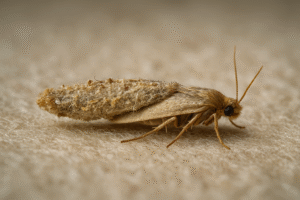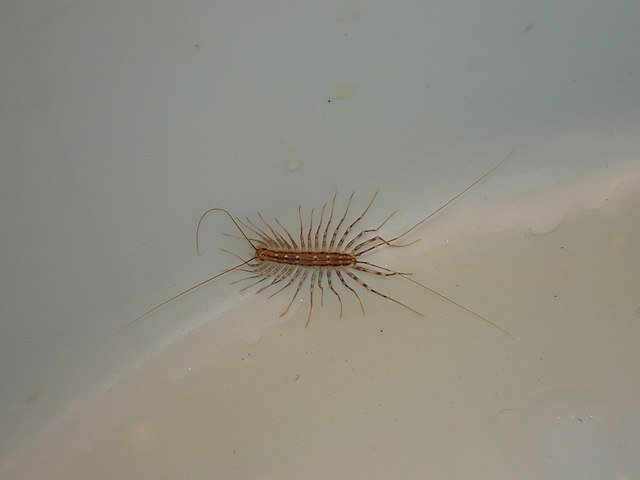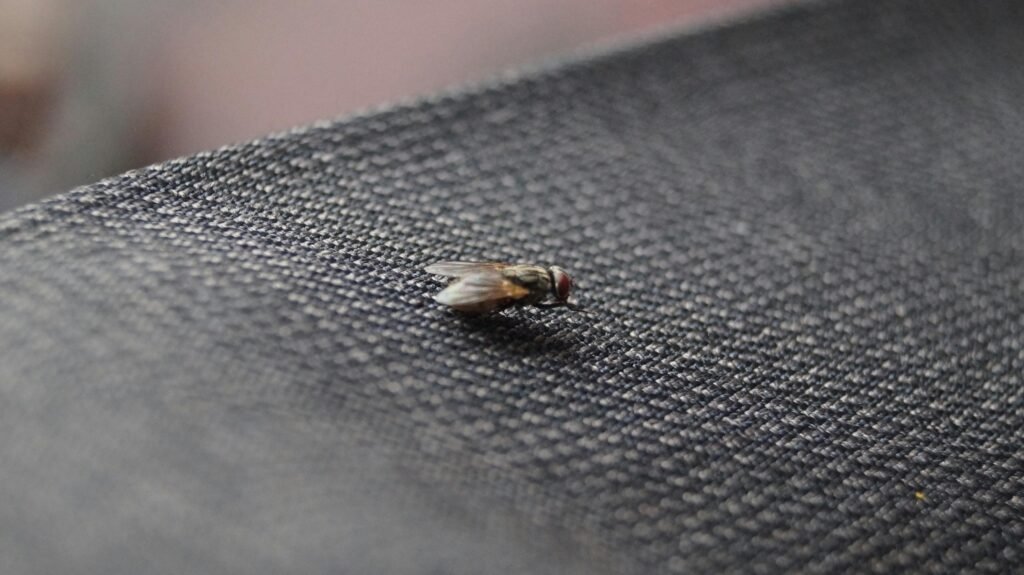Case-Bearing Clothes Moth (Tinea pellionella): Identification, Damage & Control
 It all begins with accurate problem identification. A lot of clients call me for butterflies in their closets. The Case-Bearing Clothes Moth (Tinea pellionella) is one of the most well known textile pests worldwide. The Tinea pellionella is gives a lot of cases every year, i could say that a 5% of my visits is for this pest and Tineola bisselliella . Unlike pantry pests such as the Cigarette Beetle (Lasioderma serricorne) or grain invaders like the Rice Weevil (Sitophilus oryzae), this moth specializes in feeding on keratin-based materials like wool, fur or feathers, and sometimes even leather. This behaviour makes it a very dangerous enemy for all of our clothes.
It all begins with accurate problem identification. A lot of clients call me for butterflies in their closets. The Case-Bearing Clothes Moth (Tinea pellionella) is one of the most well known textile pests worldwide. The Tinea pellionella is gives a lot of cases every year, i could say that a 5% of my visits is for this pest and Tineola bisselliella . Unlike pantry pests such as the Cigarette Beetle (Lasioderma serricorne) or grain invaders like the Rice Weevil (Sitophilus oryzae), this moth specializes in feeding on keratin-based materials like wool, fur or feathers, and sometimes even leather. This behaviour makes it a very dangerous enemy for all of our clothes.
Their exact behavior is like that: larvae create and carry on it a protective silk case, often camouflaged with fibers from the infested fabric. This trick, this portable shelter allows them to remain hidden while feeding and makes infestations harder to detect. When they call me the situation is already difficult with adults to fly around, i have to search deeply to find the camouflaged larvae. But with my expirience when i see the damages i already know what to do.
Case-Bearing Clothes Moths means big damage to clothing, rugs, and stored textiles. This is a money loss and a loss of beloved items. For museums and archives, infestations put in risk irreplaceable historical materials like books, old clothes ect.
Below i will show you some facts about their identification, biology, risks, and best practices for prevention and control.
Identification
Adult size: About 6–8 mm long, with a wingspan of 10–15 mm.
Coloration: Forewings are mottled brownish-gray with darker spots; hindwings lighter and fringed.
Larvae: Whitish caterpillars, about 6 mm when mature, living inside portable cases made of silk and fibers.
Cases: Cylindrical, 6–8 mm long, often covered with wool fibers, dust, or hair—matching the surrounding material.
Behavior: Adults avoid light and remain near dark, undisturbed storage areas.
Distinction: Unlike the Webbing Clothes Moth (Tineola bisselliella), which spins loose silk mats, case-bearing larvae always remain within their cases.
Biology and Lifecycle
Eggs: Tiny, whitish, deposited on fabrics containing keratin. A female lays 30–200 eggs.
Larvae: The damaging stage; construct portable silk cases shortly after hatching. They enlarge these cases as they grow.
Feeding: Consume wool, fur, feathers, and occasionally cotton blended with animal fibers. They avoid clean synthetic fabrics unless blended with natural ones.
Pupation: Takes place inside the case.
Adult moths: Do not feed; their sole role is reproduction.
Lifespan: Development time varies with temperature and humidity—can take from 2 months to over a year, depending on conditions.
Ecology and Distribution
Global distribution: Found worldwide, especially in temperate regions.
Habitats indoors: Closets, wardrobes, attics, basements, storage boxes, and upholstered furniture.
Habitats outdoors: Rare, but may survive in bird nests and animal burrows.
Favorable conditions: High humidity, darkness, and the presence of keratin-rich food sources.
Damage and Risks
Textiles: Larvae chew irregular holes in wool garments, carpets, blankets, and upholstery.
Animal products: Feathers, taxidermy, leather, and fur coats are highly vulnerable.
Museums and archives: Infest valuable collections, including old books bound with animal glue or parchment.
Comparison: Like Carpet Beetles (Anthrenus spp.), damage is caused by larvae, not adults.
Economic impact: In severe infestations, replacement costs can reach thousands of dollars.
Signs of Infestation
Presence of small silk cases on garments or in storage areas.
Irregular holes in woolen fabrics or fur.
Larval cases often camouflaged with fibers from the material being eaten.
Adult moths rarely seen, since they avoid light and are weak fliers.
Shed skins or frass (insect droppings) near infested items.
Household Case-Bearing Clothes Moths
Control
We should regularly check our stored woolens, carpets, and textiles for signs of case-bearing clothes moth activity and infestation. On the treatment i check for for small holes in the fabrics, loose fibers at the very end, or frayed carpet edges. You may also notice tiny silken cases or larvae hiding or crawling along seams, folds, or under furniture edges.
Cleaning/Heat treatment: Dry cleaning or washing infested fabrics at temperatures above 55°C (140°F) destroys both eggs and larvae of the case-bearing clothes moth. Ensure the entire fabric reaches the right temperature for at least 30 minutes. I know that this very dangerous for some clothes so think about dry steam steamer.
Vacuuming: It is very helpful. Essential for removing larvae and cases hidden in carpets and corners.
Storage: Use airtight containers or garment bags to store woolens ect.
Freezing: This is defficult for a house baut exposing infested fabrics to –18 °C (0 °F) for several days (more than2) kills larvae.
Exclusion: Reduce clutter and humidity and store susceptible items properly.
Professional and Long-Term Control
Integrated Pest Management (IPM): Focus on sanitation, inspection, and targeted treatments.
Insecticides: In cases of widespread infestation, insecticidal treatments should be applied by licensed professionals to cracks, crevices, and storage areas. They will advise you on the safest handling procedures and re-entry times.
Fumigation:This treatment is rarely used and should never be requested unless specifically recommended by a licensed professional. Due to potential risks, it is only applied in exceptional cases such as museum collections, severe infestations, or within the food industry under expert scientific supervision.
Monitoring: Pheromone traps and glue boards are useful monitoring tools for detecting adult clothes moths. Their purpose is not to control the infestation but to give warning of moth activity so you can take control measures. Do not put too many pheromone traps inside a house or building, it can attract moths from the neighborhood. The expert knows how to use them properly.
Comparisons: Like Drugstore Beetles (Stegobium paniceum) or Cigarette Beetles (Lasioderma serricorne), infestations often go unnoticed until damage is severe.
Final Thoughts
The Case-Bearing Clothes Moth (Tinea pellionella) is one of the most destructive textile pests worldwide causes billions of money loss every year. Like the pantry invaders such as the Cigarette Beetle (Lasioderma serricorne) or the Drugstore Beetle (Stegobium paniceum), its damage is also silent and devastating. Stored clothes can come out full of holes. and museum artifacts may suffer irreversible losses.
What makes this pest especially dangerous is that until we notice it is very late, and the damage is severe. Adult moths are rarely seen, while larvae remain hidden in their camouflaged silk cases. By the time the problem is visible, significant damage may already be done.
For homeowners, the solution is prevention, inspection, and proper conditions of storage. For institutions, an IPM approach with professional monitoring is essential. Recognizing the signs early can save not only money but also protect valuable heritage.
FAQs About Case-Bearing Clothes Moths
Q: What makes case-bearing clothes moths different from webbing clothes moths?
A: Case-bearing larvae build portable silk cases on it, while webbing clothes moth larvae spin silk mats on the fabric they infest.
Q: Can they damage synthetic fabrics?
A: Pure synthetics are usually safe as it is not their food. However, the fabrics contains some wool or animal fibers are vulnerable.
Q: Do adult moths eat clothes?
A: No. Only the larvae feed on textiles. Adults focus solely on reproduction.
Q: Are they dangerous to people or pets?
A: No. Case-bearing cloths moth are dangerous only for our cloths and fabrics. They do not bite, sting, or spread disease. Their risk is purely economic and material.
Q: How do I get rid of an infestation without chemicals?
A: Freezing or heat with dry steam are good and suitable treatments, combined with thorough cleaning, airing and of course vacuuming, are highly effective methods.
Learn more about other Urban & Indoor Pests that affect our houses and buidings.
Disclaimer
This article is for informational purposes only. Pest control laws and approved chemicals vary by country. For best results and legal safety, we strongly recommend contacting a licensed pest control professional in your local area. Always make sure that the pest control technician is properly certified or licensed, depending on your country’s regulations. It’s important to confirm that they only use approved products and apply them exactly as instructed on the product label. In most places in Europe, UK, or USA, following label directions is not just best practice—it’s the law.
Author
Nasos Iliopoulos
BSc Agronomist & Certified Pest Control Expert
Scientific Director, Advance Services (Athens, Greece)
Licensed Pest Control Business – Ministry of Rural Development & Food (GR)
References
Wikipedia – Tinea pellionella
Penn University - Clothes Moth


